Читать книгу Genetic Analysis of Complex Disease - Группа авторов - Страница 80
Segregation Analysis
ОглавлениеSegregation analysis is a modeling tool that is used to examine the patterns of disease in families and determine if the patterns are indicative of traditional genetic inheritance models (such as autosomal dominant, autosomal recessive, and polygenic) or are more consistent with nongenetic (environmental) models (Elston 1981; Morton 1982; Lalouel 1984). The likelihood of the data to fit a particular inheritance model is computed. By comparing the likelihood of several models, one can determine which model provides the “best fit” to the data. Segregation analysis does not prove that a particular inheritance model is correct but will determine if the data are consistent with that inheritance model.
The advantage of segregation analysis is that it can provide an inheritance model and parameters that may be used in parametric linkage analysis. However, generally segregation analysis can only model 1–2 loci, which may not be very useful for most complex diseases. That is, if none of the inheritance models examined in the segregation analysis can adequately accommodate the complexities of the underlying inheritance model of the disorder, even the “best‐fitting” model will not provide much information.
Additionally, this approach is extremely sensitive to ascertainment bias. In genetic analysis, families are often collected based on the presence of many affected individuals. Thus, for segregation analysis, there may be a high proportion of families with numerous affected individuals that are used in the analysis, when in reality these types of families only make up a small percentage of the disease population and most cases may be observed in families with only one or two affected individuals. For example, the probability that an affected individual will be ascertained as a proband is π, and when π = 1, all the individuals in the study population who have the condition have been ascertained. This is referred to as “complete ascertainment.” When the probability that an affected individual is a proband is very low (π approaches 0), each sibship is expected to have only a single proband. This is called “single ascertainment.” With this latter ascertainment approach, the probability that a family will come to the investigator’s attention, and be included in the study, is related to the number of affected individuals in the family. That is, the more affected the individuals in the family, the higher the likelihood that this particular family will be ascertained, thus introducing a biased distribution of family types in the analysis.
If one does not correct for the method in which the families were ascertained, the estimate of the segregation probability of the disease allele can be biased, which can affect the “best‐fitting” genetic model. In some cases, the ascertainment bias may be so great that it causes the investigator to incorrectly conclude that the disorder is consistent with a single‐gene model (Greenberg 1986). For a discussion on approaches for correcting ascertainment bias, see Khoury et al. (1993).
There are several analytic approaches to segregation analysis, each with its strengths and weaknesses. The most commonly used methods include the mixed model (Morton and MacLean 1974; Lalouel and Morton 1981; MacLean et al. 1984), the transmission probability model (Elston and Stewart 1971), the unified model (Lalouel et al. 1983) which draws on the strengths of both the mixed and transmission probability models, and the regressive model (Bonney 1984). All of these approaches are computationally intensive but are available for use in several software packages such as POINTER (Lalouel and Morton 1981), SAGE (http://darwin.cwru.edu/sage/) and PAP (Hasstedt 1993).
Segregation analysis is not widely used in the evaluation of complex diseases because it is susceptible to the presence of genetic heterogeneity, phenocopies, gene–gene and gene–environment interactions, which are quite difficult to model. Consequently, segregation analysis results that support the involvement of a major gene in a condition are much easier to interpret than results that do not support such an effect. This is especially true if there are other data to support the involvement of genetics, such as twin data or familial clustering. In spite of these difficulties, there are examples of the successful application of segregation analysis to complex disorders, even to psychiatric disorders that tend to have the additional complexity of defining a precise phenotype for investigation (evidence for a Mendelian genetic factor contributing to obsessive compulsive disease and (Nestadt et al. 2000; Notarnicola et al. 2000).
